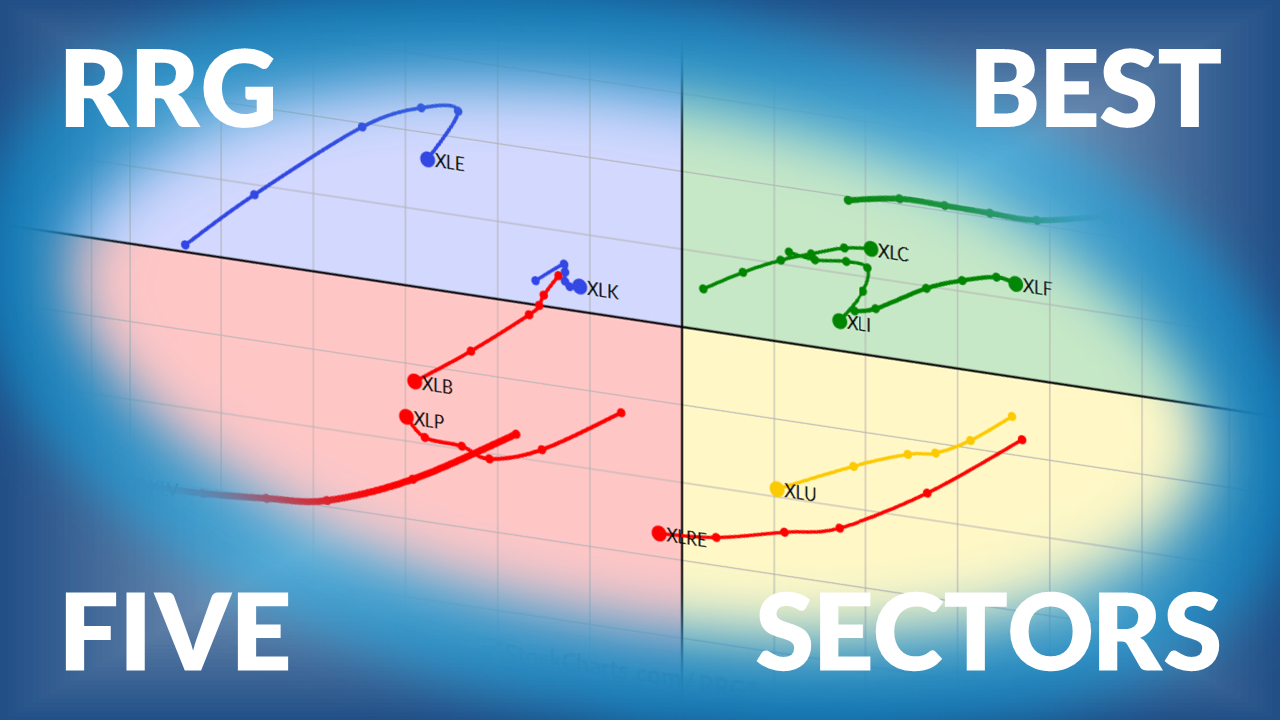OIL SURGES -- THE ENERGY SPDR AND THE OIL SERVICE HOLDRS HIT NEW HIGHS -- SEMIS REMAIN A DRAG -- NOVELLUS AND APPLIED MATERIALS LEAD SEMIS LOWER -- A LOOK AT THE PUT/CALL RATIO -- NET NEW HIGHS REMAIN BULLISH
BIG DAY FOR ENERGY... Today's Market Message was written by Arthur Hill. John Murphy will be back tomorrow. - Editor
Energy stocks and Crude Oil were standout performers once again on Wednesday. The United States Oil Fund ETF (USO) started things off with a surge above 62. Media reports suggested that crude rose on speculation that Turkey would invade northern Iraq. While that is certainly possible, I prefer to focus on the price chart first and keep speculation on the back burner. On Tuesday, strength in oil was attributed to an Energy Department report forecasting a colder winter. However, on the very same day, there was also a report out from the National Oceanic and Atmospheric Administration predicting warmer than average temperatures this winter. Go figure. These reports cancelled each other out and left market participants wondering what exactly triggered the buying in crude. Truth be told, there are many reasons for buying on any given day and we cannot be expected to know them all. Our best barometer is price itself. Price represents the sum total of ALL possible reasons and there is no quibbling over the price of the last trade.

Chart 1

Chart 2
The first chart extends back to January and shows the United States Oil Fund ETF (USO) for 2007. The ETF is trading within a rising price channel and consolidating near the upper channel trendline. The overall trend is clearly up and there is some resistance around 60-64. The second chart focuses on price action since mid August. The ETF surged above 63 and then pulled back over the last two weeks. The pullback looks like a small falling wedge or pennant and USO broke above the upper trendline today. This move reinforces support at 60 and signals a continuation higher.
OIH AND XLE SURGE... Unsurprisingly, the Oil Service HOLDRS (OIH) and Energy SPDR (XLE) also surged today. On the price chart, OIH moved to a new 52-week high in late September and then consolidated with a flat flag. The ETF became overbought after the September surge as RSI (10) moved above 70. As the ETF consolidated, RSI moved back towards the centerline (50) and this level acted as support. Today's bounce in OIH reinforces support from the late September and early October lows. More importantly, the flag breakout signals a continuation higher and the ETF forged yet another 52-week high today.

Chart 3
XLE sports a similar pattern and setup. The ETF surged to a new 52-week high in September and then consolidated with a flat flag the last three weeks. The ETF actually opened weak today, but came roaring back and broke flag resistance. XLE also recorded another new high in the process and the flag breakout is bullish. This breakout reinforces support from the late September and early October lows.

Chart 4
SEMICONDUCTOR STOCKS STILL DRAGGING... Even though the Nasdaq 100 ETF (QQQQ) edged higher on Wednesday, the Semiconductor HOLDRS (SMH) moved lower and this group continues to drag its feet. Last week Intel (INTC) and Micron (MU) were to blame for weakness. Today, the semiconductor equipment stocks weighed on the group. On the price chart, SMH gapped down last week and broke below the August trendline today. Even so, there is still some support from the 50-day moving average and last week's low around 37.75. Nevertheless, I would consider this gap and trendline break bearish as long as they hold. The ETF met resistance around 39 three times over the last six weeks and needs to clear the September highs to revive the bulls. Such a move would also fill last week's down gap.

Chart 5
Novellus Systems (NVLS) and Applied Materials (AMAT), two semiconductor equipment stocks, were among the culprits today. Novellus was range bound from mid August to early October and the stock tried to break range resistance on Monday. The breakout attempt failed and the stock gapped down today. Novellus is back in the range and we must wait for a range break to trigger the next signal. On the other chart, Applied Materials declined sharply in August and then formed a triangle consolidation. The stock declined to triangle support today and a break below 20 would be bearish.

Chart 6

Chart 7
ATMEL SURGES ABOVE RESISTANCE... All is not lost within the semiconductor group as lowly Atmel (ATML) came to the rescue with a big move on good volume. ATML surged in August and then consolidated in September with a triangle. Notice how the Bollinger Bands contracted in early October and the stock surged above the upper band today. The breakout on good volume is bullish and the next resistance area is around 6. The move also reinforces support at 5 and a break below this level would negate the whole setup.

Chart 8
PUT CALL RATIO GETTING LOW... The CBOE Total Put/Call Ratio is a popular sentiment indicator used to measure bullish and bearish extremes. The ratio is above 1 when put volume outpaces call volume and below 1 when call volume is higher than put volume. Put buying surges during bearish extremes and call buying surges during bullish extremes. On the chart below, I applied a 10-day simple moving average to smooth the data series.

Chart 9
The indicator surged above 1.20 in March and August. This showed extreme bearishness and the market (S&P 500) bottomed soon thereafter. On the downside, the indicator dipped below .90 several times and moves below this level represent a bullish extreme. Most recently, the indicator broke below .90 and its May-July lows. The trend for the S&P 500 is clearly up, but the move below .90 suggests that we may be nearing an extreme. A bit of caution is advised because this indicator can act like an overbought momentum oscillator. Don't forget that momentum oscillators can become overbought and remain overbought during strong uptrends. The S&P 500 is currently in a strong uptrend and the Put/Call Ratio could remain at a relatively extreme reading.
NET NEW HIGHS REMAIN POSITIVE... Net New Highs are positive and expanding on both the NYSE and the Nasdaq. The current uptrends in the Nasdaq and NY Composite should continue as long as this indicator remains strong. Net New Highs equals new 52-week highs less new 52-week lows. The indicator is positive when there are more new highs and negative when there are more new lows. I applied a 10-day simple moving average to smooth the data series and it is shown in "area" format (blue). The red line shows the underlying index for comparison. The basic premise is simple: The bulls are in control when Net New Highs are positive and the bears are in control when Net New Highs are negative.

Chart 10
For the Nasdaq, the 10-day SMA for Net New Highs dipped into negative territory in March and again in late July. The March sell signal coincided with a bottom in the Nasdaq and this was not a great signal. However, a buy signal materialized later that month and the indicator stayed bullish for over three months. There was a sell signal in late July and then another buy signal in late September. The indicator remains in bull mode and Net New Highs are increasing.

Chart 11
For the NYSE, the 10-day SMA for Net New Highs remained in positive territory from January until late July. Notice that the indicator did not dip into negative territory in March and remained in bull mode during this period. Net New Highs turned negative in late July and remained so until 18-Sept. The surge into positive territory coincided with the Fed rate cuts on 18-Sept and New Highs have been expanding the last three weeks. The indicator remains well below its prior highs and this is a concern, but the indicator favors the bulls as long as it holds in positive territory. Relative weakness in the Consumer Discretionary and Finance sectors is likely to blame to the short fall in Net New Highs.








